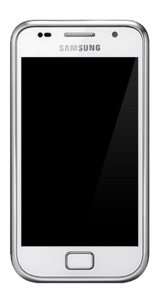
Back سامسونج جالكسي إس Arabic سامسونگ گلکسی اس AZB Samsung Galaxy S I9000 BAR Samsung Galaxy S Catalan سامسۆنگ گالاکسی ئێس CKB Samsung Galaxy S Czech Samsung Galaxy S German Samsung Galaxy S Spanish سامسونگ گلکسی اس Persian Samsung Galaxy S Finnish
A request that this article title be changed to Samsung Galaxy S (original) is under discussion. Please do not move this article until the discussion is closed. |
 | |
 | |
| Codename | Galaxy |
|---|---|
| Manufacturer | Samsung Electronics |
| Slogan | Turn on Smart Life |
| Series | Samsung Galaxy |
| Model | GT-I9000 |
| Compatible networks | Dual band CDMA2000/EV-DO Rev. A 800 and 1,900 MHz; WiMAX 2.5 to 2.7 GHz; 802.16e 2.5G (GSM/GPRS/EDGE): 850, 900, 1,700, 1,800, 1,900, and 2,100 MHz; 3G (HSDPA 7.2 Mbit/s, HSUPA 5.76 Mbit/s): 900, 1,900, and 2,100 MHz; TD-SCDMA (China Mobile Only) |
| First released | 4 June 2010 |
| Discontinued | 6 March 2012 |
| Units sold | 24 Million (as of 14 January 2013)[1] |
| Predecessor | Samsung Galaxy (original) |
| Successor | Samsung Galaxy S II |
| Related | Samsung Galaxy Player Samsung Nexus S |
| Type | Smartphone |
| Form factor | Slate (most versions) Slider (Sprint version) |
| Dimensions | 122.4 mm (4.82 in) H 64.2 mm (2.53 in) W 9.9–14 mm (0.39–0.55 in) D |
| Weight | 119 g (4.20 oz) |
| Operating system | Original: Android 2.1 "Eclair" with TouchWiz UI 3.0/4.0 Current: Android 2.3.6 "Gingerbread" with TouchWiz UI 3.0/4.0 Unofficial: Android 7.1 "Nougat" via LineageOS 14.1 (Unofficial) |
| System-on-chip | Samsung Exynos 3110 (previously known as Hummingbird S5PC110) |
| CPU | 1.0 GHz ARM Cortex A8 |
| GPU | PowerVR SGX 540 |
| Memory | 512MB RAM |
| Storage | 8 GB / 16 GB |
| Removable storage | microSDHC (up to 32 GB) |
| Battery | Removable Li-Ion 1,500 mAh Battery |
| Display | 4.0 in (100 mm) Super AMOLED with RGBG-Matrix (Pentile) 480x800 px WVGA (233 ppi) |
| External display | TV out via headphone jack and mDNIe via WiFi (HD) |
| Sound | SoundAlive, 16 kHz 64 kbit/s mono in HD video recording |
| Rear camera | 5 MP with auto focus; 720p HD video (12 Mb/s); auto-focus; self-shot, action, panorama, smile shot; face detection; anti-shake; add me |
| Front camera | VGA camera (some models) |
| Connectivity | 3.5 mm TRRS; Wi-Fi 802.11b/g/n; DLNA; Bluetooth 3.0; micro-USB 2.0; FM radio with RDS with recording |
| Data inputs | Multi-touch capacitive touchscreen display, Ambient light sensor, microphone, 3-axis Magnetometer (Compass), aGPS, 3-axis accelerometer, stereo FM radio with RDS and Swype, physical QWERTY keyboard (on Sprint version only) |
| Other | TV out, integrated messaging Social Hub, Google Play, GALAXY Apps, A-GPS, Augmented reality with Layar Reality Browser, video messaging, Exchange ActiveSync (offline and no SIM Mode), voice command, RSS reader, Widgets, Smart security[2] |
| SAR | Head: 0.325 W/kg 1 g Body: 0.422 W/kg 1 g Hotspot: -[3] |
The Samsung Galaxy S (retrospectively referred to unofficially as the Samsung Galaxy S1, Galaxy SI or simply S1) is a touchscreen-enabled, slate-format Android smartphone designed, developed, and marketed by Samsung Electronics; it is the first smartphone of the Samsung Galaxy S series. It is the first device of the third Android smartphone series produced by Samsung.[4] It was announced to the press in March 2010 and released for sale in June 2010. Due to shortage of Super AMOLED displays, Samsung released a successor to the device called S scLCD or SL and ceased production of the original I9000 model.
The Galaxy S is produced in over two dozen variations. The international 'GT-I9000' reference version features a 1 GHz ARM "Hummingbird" processor, a PowerVR SGX540 graphics processor, 2 or 4 GB of internal flash memory, a 4 in (10 cm) 480×800 pixel Super AMOLED capacitive touchscreen display, Wi-Fi connectivity, DLNA support, a 5-megapixel primary camera and a 0.3-megapixel secondary front-facing camera.[5] Derivative models may include localized cellular radios or changes to button layouts, keyboards, screens, cameras or the Android OS.
At the time of its release, the Galaxy S included the fastest graphical processing of any smartphone,[6] was the thinnest smartphone at 9.9 mm[7] and was the first Android phone to be certified for DivX HD.[8]
As of 2013, over 25 million Galaxy S units have been sold.[9] The Galaxy S name continued on with the semi-related Snapdragon-based Galaxy S Plus and NovaThor-based Galaxy S Advance smartphones. The next major release of the series was the Samsung Galaxy S II, which was introduced in May 2011
- ^ "Samsung Galaxy S smartphones sales hit 100M". ZDNet. Archived from the original on 2013-01-17. Retrieved 14 January 2013.
- ^ "Samsung Unpacked". Samsung Electronics. 18 April 2010. Archived from the original on 13 February 2010. Retrieved 2010-04-18.
- ^ https://apps.fcc.gov/oetcf/eas/reports/ViewExhibitReport.cfm?mode=Exhibits&RequestTimeout=500&calledFromFrame=N&application_id=302725&fcc_id=%27A3LGTI9000%27 Archived 2014-01-02 at the Wayback Machine, ID=1263518
- ^ "A Brief History of the (Samsung) Galaxy". Archived from the original on 2015-03-14. Retrieved 2013-06-04.
- ^ "Samsung I9000 Galaxy S - Full phone specifications". Archived from the original on 2013-06-02. Retrieved 2013-06-04.
- ^ "Samsung Galaxy S "Hummingbird" chip to have 3x GPU power of Snapdragon". Android and Me. 26 March 2010. Archived from the original on 2010-03-29. Retrieved 2010-03-27.
- ^ "5 reasons to wait for the Samsung Galaxy S", Android and Me, 30 March 2010, archived from the original on 2010-04-17, retrieved 2010-04-18
- ^ "Samsung Galaxy S is World's First DivX HD Certified Android Mobile Phone — Yahoo! Finance". Yahoo Finance. 24 August 2010. Retrieved 16 November 2010.
- ^ January 2013, Zak Islam 16 (16 January 2013). "Samsung Galaxy S Range Sells Over 100 Million Units". Tom's Hardware. Archived from the original on 3 December 2020. Retrieved 11 February 2021.
{{cite web}}: CS1 maint: numeric names: authors list (link)